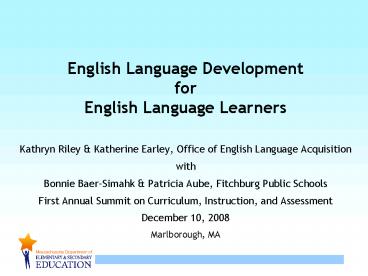English Language Development for English Language Learners - PowerPoint PPT Presentation
1 / 18
Title:
English Language Development for English Language Learners
Description:
makes the content of the lesson more comprehensible to students who ... ESL Curriculum: A Plan to Ensure District's ESL Instructional Program Addresses ... – PowerPoint PPT presentation
Number of Views:348
Avg rating:3.0/5.0
Title: English Language Development for English Language Learners
1
English Language Development for English
Language Learners
- Kathryn Riley Katherine Earley, Office of
English Language Acquisition - with
- Bonnie Baer-Simahk Patricia Aube, Fitchburg
Public Schools - First Annual Summit on Curriculum, Instruction,
and Assessment - December 10, 2008
- Marlborough, MA
2
Objectives
- Understand Sheltered English Immersion (SEI)
- Legal Background
- Implementation
- Implications for English Language Learner
Instruction - Understand the Need for an English as a Second
Language Curriculum - Understand Content-Based English as a Second
Language - Become Familiar with the Guide for Developing a
Content-based - English as a Second Language Curriculum
3
Why Sheltered English Immersion (SEI)?Legal
Background
- No Child Left Behind (NCLB) January 2002
- Accountability for Subgroups
- Accountability for LEP Subgroup
- - English Language Learning
Massachusetts English Proficiency Assessment
(MEPA) Annual Measurable Achievement
Objectives) (AMAO) Reports - - Content Learning MCAS
- Question 2 Sheltered English Immersion (SEI)
November 2002, took effect September 2003
4
What is Sheltered English Immersion?Implementatio
n
- Program Model for Most English Language Learners
- Two Components
- 1. English as a Second Language (ESL)
Instruction - explicit, direct instruction about the
English language intended to - promote English language acquisition by LEP
students and to help them - catch up to their student peers who are
proficient in English. It - includes learning outcomes in speaking,
listening comprehension, - reading and writing.
- 2. Sheltered Content Instruction
- instruction that includes approaches,
strategies, and methodology that - makes the content of the lesson more
comprehensible to students who - are not yet proficient in English.
5
Instruction within an SEI Program Model
Implications
6
Instruction within an SEI Program Model
Implications (continued)
Addressed by the SEI Professional Development
Category Training
Addressed by the ESL Curriculum Development
Project
7
Why a Guide for Developing a Content-based ESL
Curriculum? Background
- 2005 Needs Assessment Summary Findings
- High Ratio of LEP Students to ESL Teachers
- Role/Function of ESL Teachers Lacked Clarity
- Many Districts Reported Having Neither an ESL
Curriculum nor a Clear Understanding of the
Content of ESL - 2005 State Assessments Showed a Large Number of
ELLs were not Making Progress in Learning English
8
What is the Guide for Developing a Content-based
ESL Curriculum?
- New Resource Developed by
- Office of English Language Acquisition
- Massachusetts Educators
- External Partner Center for Applied Linguistics
- Guided by Four Foundational Premises
- The English Language Proficiency Benchmarks
Outcomes (ELPBO) Defines Learning Outcomes for
ESL instruction - ESL Curriculum A Plan to Ensure Districts ESL
Instructional Program Addresses ELPBO
Consistently Comprehensively - Instruction ELLs need Comprehensive, High
Quality English Language Instruction - Content-Based ESL Topics Materials ELLs
Encounter Daily in Content Classrooms Can and
Should be Used During ESL Instruction
9
Developing the Guide Assumptions Beliefs
- Curriculum, in General,
- Organizes the Content Contained in State
Standards - Sequences the Content Contained in State
Standards - Defines the Learning Outcomes for which a Teacher
of that Content is Responsible
10
Developing the Guide Assumptions Beliefs
(continued)
- 2. Roles in Curriculum Development
- - The development of a content-based ESL
curriculum, based on state standards, is the
responsibility of, and is best done by the
district - - The role of the Department is to provide the
tools for curriculum development - - The learning outcomes for which an ESL teacher
is responsible will be clearly articulated and - - The content of ESL is the language (the ELPBO
framework) and the subject matter content is
the vehicle for learning English.
11
Brief Online OverviewGuide to Content-based ESL
Curriculum Development
- Massachusetts Department of Elementary and
Secondary Education, English Language Learners
website - http//www.doe.mass.edu/ell/
- Go to Curriculum Instruction Sidebar
12
Fitchburg Public SchoolsBonnie Baer-Simahk
Patricia Aube Looking at our Strengths
- Curriculum Mapping
- Coaches
- Expert Providers
- Category 1 through 4 Training
13
Fitchburg Public Schools Bonnie Baer-Simahk
Patricia Aube Year One, 2007-2008 A Year of
Learning
- 3 ESL Teachers and 1 Math Coach
- Conducted District Inventory Materials Analysis
Evaluation Template - Mapped ESL Curriculum Student Profiles Scope
and Sequence (refer to Sample Map Word
document) - Wrote Traditional ESL Unit, Embedded Math
(refer to Sample Unit Word document) - 7th Grade ESL Teacher Math Coach
- Used the Guide to
- Design and implement a content-based mini unit
- Math to teach targeted ELPBOfocus English
Language Acquisition
14
Fitchburg Public Schools Bonnie Baer-Simahk
Patricia Aube Year Two, 2008-2009 A Year of
Implementation
- Recruited Math Teachers to Partner with ESL
teachers - Teachers Mapped ESL Curriculum
- Summer 2008 Teachers Used Tools from the Guide
to collaboratively write Content-Based ESL
Lessons - Current School Year 2008-2009
- Teachers Coach Meet Monthly Share Write
Additional Lessons - Lessons Implemented Weekly, Job Embedded Support
from ELL Support Specialist - LEP Student Preliminary Data
- Improved Classroom Interaction
- Improved Academic Performance
15
Fitchburg Public Schools Bonnie Baer-Simahk
Patricia Aube Preliminary DataNo Content-Based
ESL Lesson
16
Fitchburg Public Schools Bonnie Baer-Simahk
Patricia Aube Preliminary DataContent-Based ESL
Lesson
17
Fitchburg Public Schools Bonnie Baer-Simahk
Patricia Aube Year Three, 2009-2010 Future Plans
- Continue Curriculum Development for Content-Based
ESL - Roll Out at Other Schools in the Fitchburg School
District - Follow the Districts Lead on Mapping Other
Content Areas
18
English Language Development for English
Language Learners
- Questions
- Contact Information
- Massachusetts Department of Elementary
Secondary Education - Kathryn Riley, 781-338-3522, kriley_at_doe.mass.edu
- Katherine Earley, 781-338-3569,
kearley_at_doe.mass.edu - Fitchburg Public Schools
- Bonnie Baer-Simahk, baer-simahkb_at_fitchburg.k12.m
a.us - Patricia Aube, aubep_at_fitchburg.k12.ma.us































